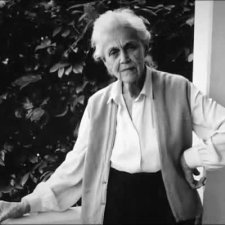Nora Heysen: Like all children, I began painting when I was about seven or eight. And we all used to settle down in Father’s studio, and lie on our tummies and draw. I used to go out with my father when I was a child. Father used to ride a bicycle with his satchel on his back, and all his sketching gear. I used to have my little bicycle with my satchel on my back, and by the time I’d got all my oil paints out and my palette fixed up, there was Father with a finished picture. He’d say, “Well, what on earth have you been doing? You haven’t even got a beginning yet.” My nature didn’t lend itself to this quick watercolour painting. I wanted to model things, and get things in the round.
Numbers of artists used to visit the old home. Father asked us children to bring out our work to show what we could do, and I remember that mine got the first prize, and that was a first step towards giving me confidence, really, to go on.
I used to milk cows before I went down to the art school each day, and when I got home at night, and my father was all in favour of this because he said, “If you’re going to be an artist, you need to be healthy and physically fit.” And how true he was. But I’m thankful to this day because I have an enormously strong right arm.
My first interest was perhaps flowers, and people. I remember when I was a war artist right up in the steaming jungle of New Guinea, I’d arranged myself a beautiful native bowl full of flowers, and I was sitting in the mess painting this when I had a signal to be moved on down to Lae, and I ignored the signal and said, “Go away. I’m in the middle of painting flowers.” And I continued.
Now I think I’ve found my own environment in an old home in Hunters Hill, in a very wandering wilderness of a garden, and the atmosphere is peaceful, and very inducive to my work.
This peaceful spot is not so remote that I’m not all too aware of what is going on in the art world. It is very hard to find what is true to oneself. One’s own individual way of saying something is the important thing.










